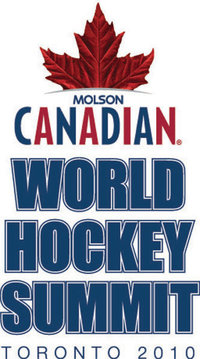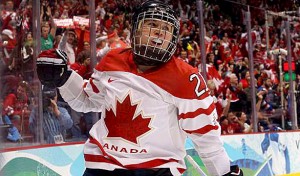It’s time for a Women’s National Hockey League
 During the final day of the World Hockey Summit it became abundantly clear that Hockey Canada, USA Hockey and especially the National Hockey League need to become more proactive in the growth of women’s hockey.
During the final day of the World Hockey Summit it became abundantly clear that Hockey Canada, USA Hockey and especially the National Hockey League need to become more proactive in the growth of women’s hockey.
It’s something that has been at the back of my mind since the Winter Olympics in Vancouver last February – how can an exciting game like women’s hockey only really be seen on TV every four years? What can be done?
Outside of the collegiate game in the United States and Canada there is no forum for elite women’s hockey. Even at the amateur level there are many municipalities that don’t have leagues for female players, and at the World Hockey Summit there were stories of towns that won’t let women use the arenas, period.
Further, there is no junior hockey for ladies - although women are allowed to play in the three leagues that comprise the Canadian Hockey League.
At the professional level there have been several attempts at running leagues, including the Canadian Women’s Hockey League that has teams in Montreal, Mississauga, Burlington, Brampton, Vaughn and Ottawa.
The CWHL competes for the Clarkson Cup against teams from the Western Women’s Hockey League. The WWHL has franchises in Calgary, Edmonton, Winnipeg, Strathmore and Minnesota.
Although I admire these leagues ambitions, they’re unstable with teams folding or relocating constantly. Other leagues like them have collapsed under the financial and administrative strains of running a professional association.
This is where the NHL needs to step in, and form a WNHL, much like the National Basketball Association’s WNBA, to market and promote a high-calibre female version of hockey.
Like the WNBA model, all the teams could be owned by the NHL or its franchises at first, and as they become more solvent be sold to third parties. Every team would be associated with an NHL or American Hockey League franchise to guarantee cheaper access to facilities and to enable cross promotion.
It would be an easy sell to have a NHL/WNHL double-bill in several traditional hockey markets like the Original Six, in the six Canadian NHL cities and a few other hotbeds like Minneapolis.
Further, when I threw it out to my Twitter followers last week, reader @katylalonde pointed out that there are several locations begging for hockey like Winnipeg, Kitchener, Hamilton and Quebec City. It would be a smart move for all four municipalities to invite a WNHL franchise to their rinks and prove that their arenas are viable venues for professional hockey.
Of course, such an initiative would have to be supported at the amateur level. Hockey Canada, USA Hockey and regional associations would need to do more to promote the women’s game at the amateur level. But with professionals serving as role models, it shouldn’t be too hard.
This is the kind of program that is prime for implementation - all it would takes is a motivated NHL willing to capture the interest of a whole new market of hockey fans.
World Hockey Summit – Day 4
 The fourth and final day of the 2010 World Hockey Summit focused on moving hockey forward and continuing to spread the good word about Canada’s favourite sport.
The fourth and final day of the 2010 World Hockey Summit focused on moving hockey forward and continuing to spread the good word about Canada’s favourite sport.
After an early breakfast the conference met in the Toronto Sheraton’s downstairs hall to listen to players, coaches and organizers speak about the movement to promote women’s hockey.
Like the previous day’s sessions on the Olympics and a World Hockey Agenda, all the members of the panel acknowledged that the 2010 Vancouver Games had done wonders for their sports’ public profile.
However, unlike Wednesday’s slanging match, keynote speaker Hayley Wickenheiser and the panel of Mel Davidson, Mark Johnson, Arto Sieppi, Angela Ruggiero and Peter Elander all agreed that women’s hockey had to return to the Olympics as well as stage more international and even professional matches.
Ruggiero made an important point about high calibre women’s play: as a member of Team USA she plays, on average, ten games per year. That’s it.
Once a player graduates from the NCAA, there is no viable professional women’s league. An individual looking to improve their game beyond the confines of a varsity program has to arrange her own ice time and practicemates, a surprisingly difficult task.
This lead to a lengthy discussion amongst the panel, and later amongst the break-out groups, about how to go about creating a professional women’s league that would allow elite female players to hone their skill and provide aspiring hockey players with ready-made heroes.
Promoting hockey to women dovetailed perfectly with the afternoon’s session on Growing Participation in hockey.
Tommy Boustedt of Sweden, Sieppi (again) of Finland, Scott Smith of Hockey Canada and Pat Kelleher of USA Hockey all discussed the particular challenges of promoting hockey in their respective countries.
Both Sweden and Finland focus on education of coaches, players and parents through intensive hockey schools open to all amateur players, while USA Hockey is concerned with branching out past the Three Ms: Michigan, Massachusetts and Minnesota.
Canada, of course, doesn’t have to worry about popularizing the game or breaking into new markets. Instead, their focus is on developing accessibility for low-income families and New Canadians as well as promoting women’s and sledge hockey.
Dr. Paul Dennis of the Canadian Hockey League, Cyril Leeder of the Ottawa Senators and John McDonough of the Chicago Blackhawks also contributed by addressing how their organizations interact with local communities to promote hockey and win over new fans to the game.
Although it was the least exciting of the presentations, that final session served as a fitting end to four days of hockey talk. It put a positive spin on the Summit and insured that the hundreds of delegates would be energized to go out and continue their hard work.
Canada/USA has made me into a fan of women’s hockey
 I am embarrassed to admit that last night was the first time I have ever watched a women’s hockey game from start to finish. A terrible sin, I know.
I am embarrassed to admit that last night was the first time I have ever watched a women’s hockey game from start to finish. A terrible sin, I know.
I had seen periods from games or seen bits and pieces, but for a host of reasons I’ve never been able to sit and watch a women’s game to completion. But I’m glad I finally did.
It was the perfect game to watch as Canada held on to an early 2-0 lead to down their arch-rivals from the United States and win their third consecutive Olympic gold medal.
There was a lot to like about the match-up. As the prohibitive favourites in any international tournament, the North American teams had often locked up at the highest levels of competition, whether at the Olympics or World Championships. As a result, the two teams are very familiar with each other’s tactics and strategies.
It quickly became apparent that women’s hockey has a style all its own thanks largely to the prohibition of body checking.
Personally, I’ve always thought this was a sexist rule that implied that women were too fragile to withstand physical play. It just made no sense – why could a woman not safely hit another woman? They would be physical equals, with no particular danger of injury.
However, the lack of big hits means that the scourge of entertaining hockey – the Trap – is impossible. The resulting game is fast and free-flowing with few stops in play. It’s refreshing compared to the National Hockey League where clogging the neutral zone has often been the fastest way to the playoffs.
The players on both teams were exceptional passers and play makers. Throughout the game there were creative tape-to-tape passes generating scoring chances. The Canadians in particular had a knack for finding each other on the ice.
When they had those openings, the Canadians were patient, waiting for defenders to over-commit themselves to a blocked shot. Canada often exploited their opponents’ mistake with a sharp pass for another quality chance. It was inspiring hockey.
Team Canada was also impressively dedicated to defence, dropping to their knees to block shots and passes, fending off a 5-on-3 power play for nearly a minute and a half at the start of the second period.
It was a lot of fun to watch, with both teams evenly matched.
That said, I don’t regret missing any of their other games. They were all lopsided blowouts that made me feel bad for the have-nots in women’s hockey. This is the sport’s greatest weakness – only a Canada-USA match-up showcases the very best of the game. Every other pairing is horribly one-sided.
When the next world championship rolls around, I’ll make sure to watch – as long as the game has Canada and the USA in it.
A side note: The fact that Team Canada had to apologize for their celebratory drinks and cigars on the ice is utter nonsense. The arena had emptied out and they were revelling in their success in what should have been a private moment. They should be allowed to let their hair down, guilt free.
I won’t go on any further, as too much ink has already been spilled over this story.